How Much Wet and Dry Food to Feed My Dog: A Comprehensive Guide
- Houndsy
Table of Contents
- Introduction
- Understanding Your Dog’s Nutritional Needs
- Calculating the Right Food Portion
- Understanding Dry and Wet Food
- Specific Feeding Guidelines by Life Stage
- Monitoring Your Dog’s Health and Weight
- Key Takeaways
Introduction
Did you know that nearly 59% of dogs in the United States are classified as overweight or obese? This alarming statistic highlights a critical issue for dog owners: ensuring our furry friends receive the right amount of food is essential for their health and longevity. As responsible pet parents, we want to provide our dogs with balanced nutrition while avoiding the pitfalls of overfeeding or underfeeding.
In this blog post, we will explore the important question many dog owners ask: how much wet and dry food to feed my dog? We will delve into the factors that influence feeding amounts, provide guidelines for different life stages, and discuss the merits of combining wet and dry food. By the end of this guide, you will have a clearer understanding of how to tailor your dog’s diet to meet their unique needs and enhance their overall well-being.
We invite you to reflect on your own pet feeding routines as we navigate this topic together. After all, the feeding ritual is not only about nourishment; it’s about bonding with our pets and ensuring they thrive in our care.
Understanding Your Dog’s Nutritional Needs
The Basics of Dog Nutrition
Like humans, dogs require a balanced diet to maintain their health, energy levels, and overall well-being. Their nutritional needs can be broken down into several key components:
- Proteins: Essential for growth, repair, and overall health.
- Fats: Provide energy and support cell function.
- Carbohydrates: Offer a source of energy and help with digestion.
- Vitamins and Minerals: Necessary for various bodily functions and to support the immune system.
Understanding these foundational elements is crucial when determining how much food to feed your dog.
Factors Influencing Food Requirements
There are several factors that can affect how much food your dog needs:
- Age: Puppies require more calories for growth compared to adult dogs. Senior dogs, on the other hand, may need fewer calories as their activity levels decrease.
- Size and Breed: Larger breeds generally require more food than smaller breeds. However, smaller breeds may have higher caloric needs per pound of body weight due to their faster metabolism.
- Activity Level: More active dogs will burn more calories and therefore need more food compared to couch potatoes.
- Health Status: Dogs with certain health conditions may require specialized diets, which can affect their caloric intake.
Calculating the Right Food Portion
Reading Food Labels
The first step in determining how much to feed your dog is to consult the feeding guidelines on the dog food packaging. These recommendations typically provide a range based on your dog's weight, age, and activity level.
For example, a standard guideline might suggest that a 30-pound dog requires about 2 to 3 cups of dry food per day, depending on its activity level. However, remember that these are just starting points.
Weighing Your Dog
To accurately adjust your dog's diet, it’s essential to know their current weight. If you don’t have access to a vet scale, you can use a bathroom scale:
- Weigh yourself.
- Hold your dog and step back on the scale.
- Subtract your weight from the total weight to find your dog’s weight.
Keeping track of your dog's weight regularly will help you make necessary adjustments to their feeding routine.
Body Condition Scoring
In addition to weight, you can assess your dog's body condition score (BCS) to determine if they are at a healthy weight. A BCS chart will help you evaluate whether your dog is underweight, at a healthy weight, or overweight. This visual tool is beneficial in fine-tuning your dog’s diet.
Understanding Dry and Wet Food
Dry Food (Kibble)
Dry dog food is a popular choice among pet owners because it’s convenient, has a long shelf life, and is generally more affordable. However, it may lack moisture, which is essential for hydration.
Benefits of Dry Food:
- Convenient and easy to store.
- Typically lower in calories compared to wet food.
- Supports dental health by reducing plaque buildup.
Wet Food
Wet dog food often contains higher moisture content, which can be beneficial for hydration, especially in dogs that may not drink enough water.
Benefits of Wet Food:
- Typically more palatable, making it a good option for picky eaters.
- Higher moisture content helps with hydration.
- Can be mixed with dry food for added variety.
Combining Wet and Dry Food
Many pet owners choose to offer a combination of wet and dry food, enjoying the benefits of both. If you decide to mix the two, it’s important to calculate the caloric content of each type.
For example, if you want to feed a 50% wet and 50% dry food mix, you would need to adjust the portion sizes accordingly:
- Step 1: Determine the daily requirement for dry food (e.g., 2 cups).
- Step 2: Determine the daily requirement for wet food (e.g., 1 can).
- Step 3: Adjust portions based on the desired ratio.
If your dog’s daily requirement is 2 cups of dry food and 1 can of wet food, you would divide these amounts to maintain the balance you prefer.
Specific Feeding Guidelines by Life Stage
Puppies
Puppies have higher energy and nutritional needs to support their rapid growth. They should be fed a diet rich in proteins and fats, and typically require more frequent meals.
- Feeding Schedule: Puppies should be fed three to four meals a day until about six months of age.
- Portion Size: Consult the feeding guidelines on the puppy food packaging, as these will vary based on the brand and breed size.
Adult Dogs
Adult dogs have more stable nutritional needs, but still require a balanced diet to maintain their health.
- Feeding Schedule: Most adult dogs do well with two meals a day.
- Portion Size: Again, refer to the dog food packaging for feeding guidelines based on your dog’s weight and activity level.
Senior Dogs
As dogs age, their metabolism slows, and they typically become less active. Therefore, senior dogs often require fewer calories.
- Feeding Schedule: Two meals a day is generally sufficient, though some owners may prefer smaller, more frequent meals.
- Portion Size: Consult your veterinarian to adjust portion sizes based on your dog’s health status and weight.
Monitoring Your Dog’s Health and Weight
Regular Vet Check-Ups
Regular veterinary check-ups are essential for monitoring your dog’s weight and overall health. Your vet can provide insights into whether your dog’s dietary needs are being met and help you adjust food portions as necessary.
Identifying Overfeeding and Underfeeding
It’s crucial to recognize signs of overfeeding or underfeeding:
- Overfeeding Signs: Weight gain, lethargy, difficulty exercising, and a lack of energy.
- Underfeeding Signs: Weight loss, excessive hunger, lack of energy, and dull coat.
Key Takeaways
Feeding your dog the appropriate amount of food is a vital part of responsible pet ownership. By understanding your dog's nutritional needs and regularly assessing their weight and body condition, you can ensure they thrive.
We encourage you to consider the benefits of the Houndsy Kibble Dispenser for a convenient and stylish solution to your dog feeding routine. With its mid-century modern design, perfect portion control, and ergonomic convenience, it’s the perfect addition to your pet care toolkit. Explore the Houndsy Kibble Dispenser here.
FAQ
1. How much should I feed my dog? Start with the feeding guidelines on your dog food’s packaging, adjusting based on your dog’s weight, activity level, and health status.
2. Can I mix wet and dry food? Yes! Mixing wet and dry food can provide variety and added moisture. Just be sure to adjust portion sizes based on caloric content.
3. How often should I feed my dog? Most adult dogs do well with two meals a day, while puppies may require three to four meals. Consult your vet for personalized advice.
4. What if my dog is overweight? If your dog is overweight, consult your veterinarian for a tailored weight management plan, which may include adjusting portions or switching to a lower-calorie food.
5. How do I know if my dog needs more or less food? Regularly assess your dog’s weight and body condition score, and consult your vet if you notice significant changes or have concerns about their diet.
By following these guidelines, we can help our beloved pets lead healthy, happy lives.












